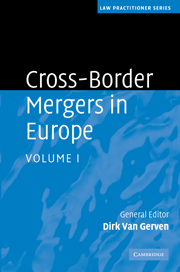Book contents
- Frontmatter
- Contents
- Contributors
- Preface
- Part I EC rules on cross-border mergers
- Part II Application in each Member State National reports for the EU Member States
- 5 Austria
- 6 Belgium
- 7 Bulgaria
- 8 Cyprus
- 9 Czech Republic
- 10 Denmark
- 11 Estonia
- 12 Germany
- 13 Hungary
- 14 The Netherlands
- 15 Poland
- 16 Slovak Republic
- 17 United Kingdom
- Part III Application in the EEA Member States
- Part IV Annexes
- Index
10 - Denmark
from Part II - Application in each Member State National reports for the EU Member States
Published online by Cambridge University Press: 03 May 2010
- Frontmatter
- Contents
- Contributors
- Preface
- Part I EC rules on cross-border mergers
- Part II Application in each Member State National reports for the EU Member States
- 5 Austria
- 6 Belgium
- 7 Bulgaria
- 8 Cyprus
- 9 Czech Republic
- 10 Denmark
- 11 Estonia
- 12 Germany
- 13 Hungary
- 14 The Netherlands
- 15 Poland
- 16 Slovak Republic
- 17 United Kingdom
- Part III Application in the EEA Member States
- Part IV Annexes
- Index
Summary
Introduction
1. The Cross-border Merger Directive has been implemented in Denmark in Chapter 15a of the Danish Public Limited Companies Act (the ‘Companies Act’) which entered into force on 1 July 2007. The basic rule in Chapter 15a of the Companies Act is that the rules on domestic mergers also apply to cross-border mergers unless otherwise indicated in that chapter.
2. A cross-border merger is defined as a merger where the merging companies are governed by the laws of at least two different Member States of the European Union or the European Economic Area (Norway, Iceland and Liechtenstein).
Scope of the new rules
3. Chapter 15a of the Companies Act only applies to public limited companies (aktieselskaber). However, in connection with the introduction of Chapter 15a in the Companies Act, identical rules were introduced in the Private Limited Companies Act governing private limited companies (anpartsselskaber).
4. In addition, rules on cross-border mergers have been introduced in the Danish Act on Undertakings Carrying on Business for Profit. These rules are similar to Chapter 15a of the Companies Act and allow limited liability companies covered by the said Act to complete a cross-border merger with similar EU or EEA companies, provided the laws of the other company's home country permit such a merger. The rules only apply to limited companies. Finally, the Danish Minister of Commerce has been authorised in the Danish Act on Trusts Carrying on Business for Profit to lay down rules on cross-border mergers of trusts covered by the Act.
- Type
- Chapter
- Information
- Cross-Border Mergers in Europe , pp. 169 - 183Publisher: Cambridge University PressPrint publication year: 2010
- 1
- Cited by

